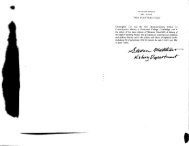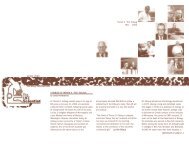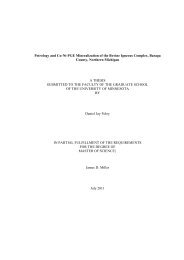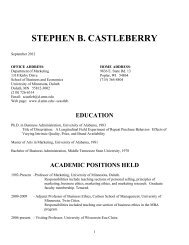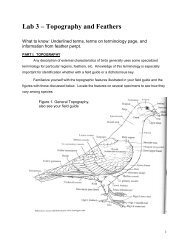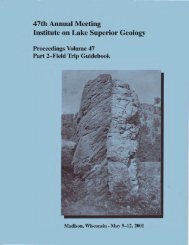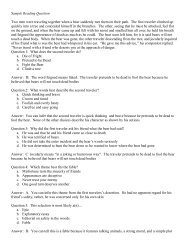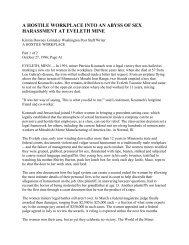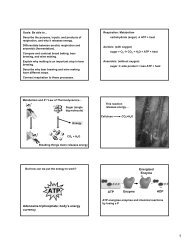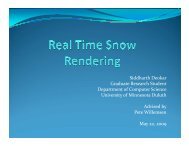POSTCRANIAL SKELETON AND LOCOMOTOR ADAPTATIONS ...
POSTCRANIAL SKELETON AND LOCOMOTOR ADAPTATIONS ...
POSTCRANIAL SKELETON AND LOCOMOTOR ADAPTATIONS ...
Create successful ePaper yourself
Turn your PDF publications into a flip-book with our unique Google optimized e-Paper software.
Skull_Skeleton_Lab3.doc 09/21/09 page 22 of 43<br />
Figure 37. Hindlimb of some of the specimens available in the lab today. Included are the<br />
Norway rat (Rattus norvegicus), echidna or spiny anteater (Tachyglossa sp.), and the rabbit<br />
(Oryctolagus cuniculus).<br />
Adaptations to Distinctive Habitats<br />
See Color Handout<br />
Terrestrial adaptations.--Early mammals were small, terrestrial, pentadactyl quadrupeds. They<br />
had the ancestral limb structure discussed above with a stance in which the sole of the foot<br />
contacts the ground as the animal walks. This plantigrade stance persists or has developed<br />
secondarily in many mammals. When running many plantigrade mammals increase the effective<br />
length of the leg by lifting the heel off the ground for cursorial (running) locomotion. Some<br />
carnivores that rely on running speed and endurance to catch their prey are always in a digitigrade<br />
stance. Compare the lengths and relative positions of the various limb bones for digitigrade and<br />
plantigrade mammals.<br />
Some prey species stand only on the longest, medial digits. The side toes were reduced, and the<br />
remaining digits strengthened and elongated. The claws increased in size to support the toes and<br />
eventually surrounded the tips, creating hooves which are the only parts of the feet to touch the<br />
ground. Members of two living orders show this unguligrade stance--most artiodactyls and the<br />
horse. Most artiodactyls have two digits of equal size on each foot. Pairs of metacarpals and<br />
metatarsals are often fused to form a single cannon bone to reinforce stability and strength.<br />
Horses (Equidae) have only the medial digit in each foot. Many artiodactyls and Equids have also<br />
reduced and fused the ulna to the radius and the fibula to the tibia. This results in only a single<br />
bone in the middle segment of the limbs. The trend towards long limbs specialized for high speed<br />
is generally accompanied by reduced lateral mobility.<br />
Figure 38. Front and lateral views of a horse (Equus caballus) limb and front view of a cow (Bos<br />
taurus) limb in the laboratory. Also included are 2 front views of an Irish elk (Megaloceros<br />
giganteus) forelimb at the Smithsonian Museum of Natural History.<br />
See Color Handout<br />
A foot with an even number of toes is called paraxonic; the toes are situated beside (para) the<br />
axis of symmetry of the foot. A foot with an odd number of toes is mesaxonic; the axis of<br />
symmetry passes through the middle (meso) of the foot. Examine mounted limbs of unguligrade<br />
mammals (Fig. 38). Compare lengths and arrangement of elements with those of digitigrade<br />
mammals. What joint(s) restrict lateral movement in the unguligrade limb?<br />
When a running squirrel or rabbit jumps forward, the stronger and longer hind legs leave the<br />
ground last, and the front legs touch it first when the animal lands. The hind limbs provide the<br />
major part of the thrust. Several mammals, including lagomorphs (other than pikas) and many<br />
rodents, use this saltatorial locomotion. In contrast, kangaroo rats and kangaroos are completely<br />
bipedal. Their front feet are not used for locomotion. The hind feet are elongated and the usually<br />
strong, long tails provide support and counterbalance. Locomotion of animals like the kangaroo is<br />
termed ricochetal.




